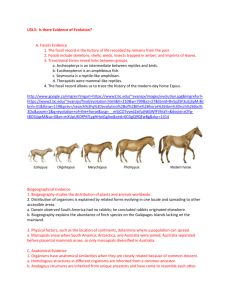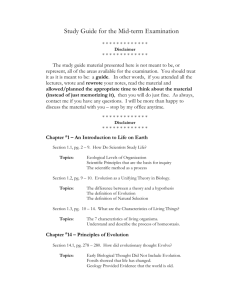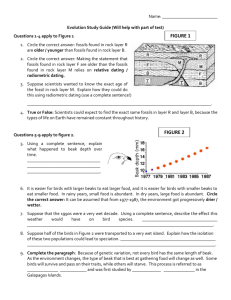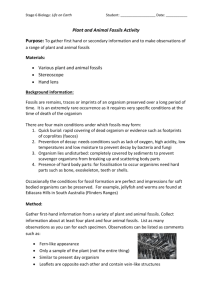Evidence for Evolution Cloze Worksheet
advertisement
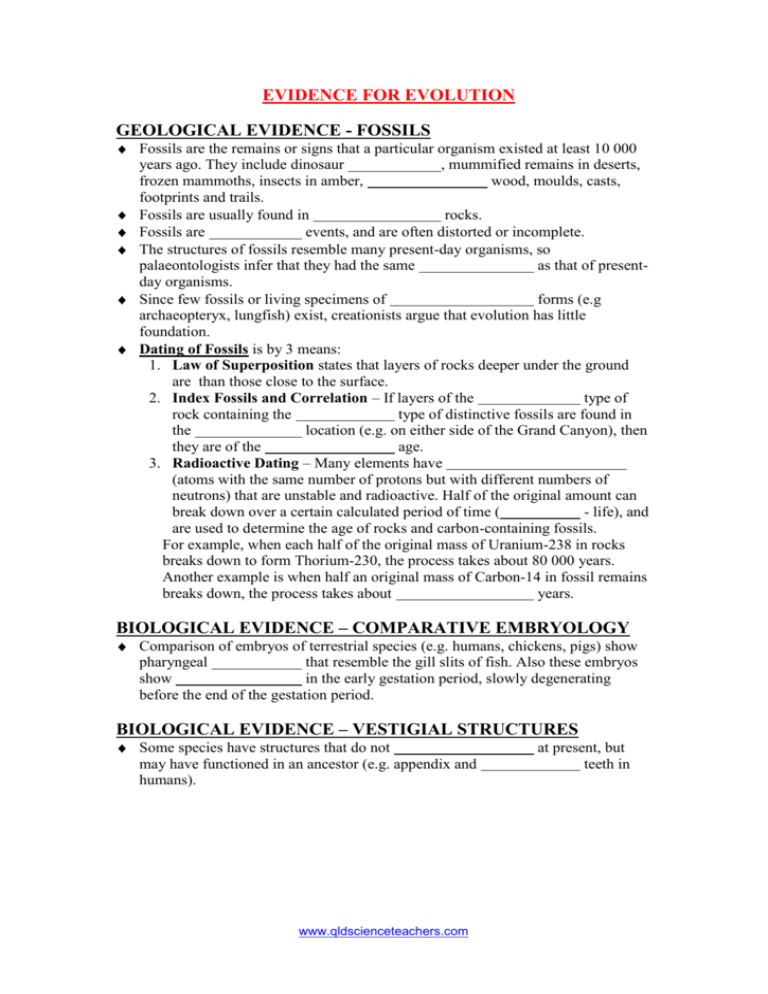
EVIDENCE FOR EVOLUTION GEOLOGICAL EVIDENCE - FOSSILS Fossils are the remains or signs that a particular organism existed at least 10 000 years ago. They include dinosaur , mummified remains in deserts, frozen mammoths, insects in amber, wood, moulds, casts, footprints and trails. Fossils are usually found in rocks. Fossils are events, and are often distorted or incomplete. The structures of fossils resemble many present-day organisms, so palaeontologists infer that they had the same as that of presentday organisms. Since few fossils or living specimens of forms (e.g archaeopteryx, lungfish) exist, creationists argue that evolution has little foundation. Dating of Fossils is by 3 means: 1. Law of Superposition states that layers of rocks deeper under the ground are than those close to the surface. 2. Index Fossils and Correlation – If layers of the type of rock containing the type of distinctive fossils are found in the location (e.g. on either side of the Grand Canyon), then they are of the age. 3. Radioactive Dating – Many elements have (atoms with the same number of protons but with different numbers of neutrons) that are unstable and radioactive. Half of the original amount can break down over a certain calculated period of time ( - life), and are used to determine the age of rocks and carbon-containing fossils. For example, when each half of the original mass of Uranium-238 in rocks breaks down to form Thorium-230, the process takes about 80 000 years. Another example is when half an original mass of Carbon-14 in fossil remains breaks down, the process takes about years. BIOLOGICAL EVIDENCE – COMPARATIVE EMBRYOLOGY Comparison of embryos of terrestrial species (e.g. humans, chickens, pigs) show pharyngeal that resemble the gill slits of fish. Also these embryos show in the early gestation period, slowly degenerating before the end of the gestation period. BIOLOGICAL EVIDENCE – VESTIGIAL STRUCTURES Some species have structures that do not may have functioned in an ancestor (e.g. appendix and humans). www.qldscienceteachers.com at present, but teeth in BIOLOGICAL EVIDENCE – HOMOLOGOUS STRUCTURES Analogous structures are anatomical structures that are found in many unrelated organisms. For example, wings of birds and serve the same function of flight. These similar structures do show signs of an evolutionary relationship. Homologous structures are structures that are similar (e.g. the pentadactyl or five-fingered structure of a human compared with the fivefingered structure of a ) and also show signs of an evolutionary relationship. BIOLOGICAL EVIDENCE – VARIATION DUE TO SEXUAL REPRODUCTION Asexual reproduction produces organisms or new cells identical to the parent organism or cell. Sexual reproduction occurs where a male sperm or a pollen grain combines with the female egg to produce similar but identical offspring. In the event of a major change, many sexually reproducing organisms will survive because of the of characteristics they have. BIOLOGICAL EVIDENCE – SYMBIOSIS Some organisms live amicably inside organisms, sometimes to the benefit of both (e.g. alga and fungus in ). It may be that eukaryotic cells were formed from a smaller bacterium invading a larger cell. Evidence comes from mitochondria and chloroplasts that both contain BIOLOGICAL EVIDENCE – SPECIALISATION IN ALGAL COLONIES Colonies of many algal types exist, where each individual algal cell is physically attached to other algal cells, but no interaction occurs between cells. However, Volvox is a ‘ball’ of algal cells which have one end responsible for movement, while another part of the ‘ball’ is responsible for reproduction. This may be evidence for the development of organisms from unicellular organisms. BIOLOGICAL EVIDENCE – PEPPERED MOTH This is observed example of Natural Before the Industrial Revolution in England, a forest-dwelling moth (Biston betularia) grew in 3 shades – light, peppered and dark. As the tree bark was lighter, the most common shade of moth was the peppered one. However, after the soot from the factories darkened the barks of trees in the moth habitat, the most common moth was the one. The reason was probably because the light and peppered moths were no longer and were being by predators. The dark moths then reproduced, changing the gene frequencies of the population. www.qldscienceteachers.com BIOCHEMICAL EVIDENCE – BACTERIAL RESISTANCE TO ANTIBIOTICS This is an observed example of Natural Selection. Bacteria do become resistant to antibiotics. Either they carry the genetic trait for resistance or they Before World War II, there were different kinds of bacteria – some which were resistant to and some which were not. After the widespread use of antibiotics during and after World War II that killed most of the non-resistant bacteria, the resistant bacteria continued to even more due to lack of competition. Their genetic resistance was passed on to subsequent generations. Many of the bacteria that we encounter today are to our present antibiotics. BIOCHEMICAL EVIDENCE – MUTATIONS A mutation is a change in the sequence of a DNA molecule or of a chromosome. A mutagen is a chemical or a form of that can cause a mutation. Since DNA controls the synthesis of (e.g. skin collagen, hair keratin, muscle myosin, hormones, enzymes, haemoglobin, antibodies), the proteins formed may be affected. Mutations can occur naturally. However, they are events (about 1 in every 100000 generations). However, mutations of fruit flies are believed to be since mutated flies seem to be in few numbers. One of the bases on which the theory of evolution is built is that chance mutations formed new organisms which could no longer mate with the rest of their species and eventually formed new species. However, since mutations observed in fruit fly experiments are so rare and often cause harm to the individuals, creationists argue that evolution in this way is not plausible. BIOCHEMICAL EVIDENCE – DNA HYBRIDISATION The DNA strands of different species of primates can be compared when they are unwound and the strands compared for similarities in sequence. DNA of humans and have a much greater similarity (97.6%) than humans and gibbons (94.7%), leading to the idea that humans may have evolved from chimpanzees, and not from BIOCHEMICAL EVIDENCE – AMINO ACID SEQUENCING When comparing the amino acid sequence of haemoglobin in various primates, the sequences are also more similar for humans and chimpanzees, than for humans and gibbons. Again, an assumption could be made that evolved from chimpanzees. www.qldscienceteachers.com

